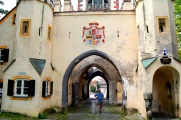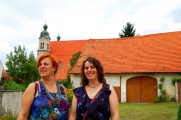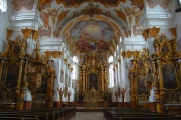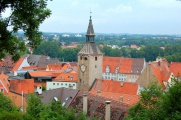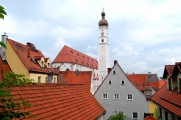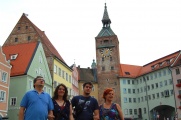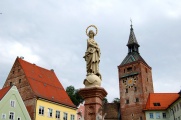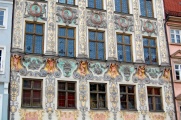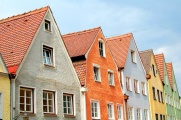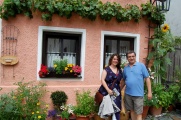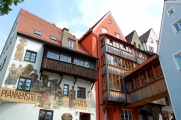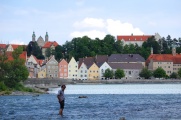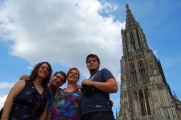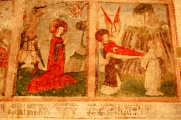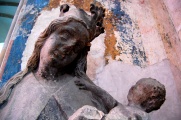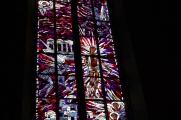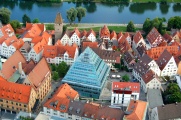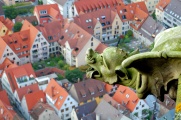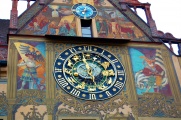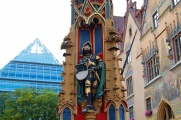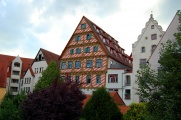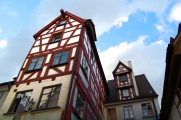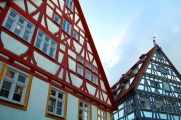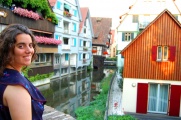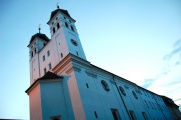Contents |
Visit of Elena's parents (August 2012) - part 1
Julio, Inma and Guille, the family of Elena, came to visit us for 17 days in August. We took some time off to visit a few places of interest with them, which we record here, in three parts:
Part 1 - a loop to Baden-Württemberg · part 2 - The klamms · part 3 - Czechia
On the first day after I arrived (from ICPS), we went for a day-excursion to visit Ulm. We stopped by Landsberg and a few other sites nearby.
Landsberg am Lech
Landsberg lays at the intersection between the Romantische Straße and the A96, so it was an easy scenic spot to pass by. It is a niece Bavarian village (or maybe even city) with colourful houses and traces left of the medieval times. The Marienbrunnen (Maria fountain) on the main square shows a virgin with a lively and spirited expression, a typical case where the model takes over the godly image it should have inspired. The Baroque dome of the church (from 1692) houses one of the oldest belfries of Bavaria (1417). It also has nice cascades on the river.
Introducing Guille (third from the left), on the main square.
One of them, a bit apart, with Elena and Julio.
Elena and Inma in front of the Lech river,
Ulm
The main destination of the day was actually Ulm, but Landsberg kept us much more time than we had scheduled for it. In Ulm, our main destination was, of course, the minster, in particular, the famous 161.53 meters spire, the highest in the world. Ascending the 768 steps seems never-ending. It is a little-initiatory experience, though, as the way keeps narrowing as you get near to the top, feeling like falling upward in a trap of stones. From the top, we could locate Inma and Julio, who didn't want to join, and captured them in a photo (shown below) where they appear as roughly 200 pixels shadows (reddish and bluish) like this ![]() . You can probably distinguish Julio better, because he was walking.
. You can probably distinguish Julio better, because he was walking.
Much time was spent inside the Minster too, declared complete 613 years after building began, because of the spires (a similar fate happened to the cathedral of my birth-city, Clermont-Ferrand, which also has rather tall spires, about 108 meters.) It would be too long even to list the art inside. Julio was particularly puzzled by stairs failing to reach a pulpit. In the selection, below, I show a nice Fresco (1456) in the southern porch, which relates some episodes of the legend of Saint Catherine. Catherine of Alexandria, having decided to remain a virgin all her life, settled with marrying someone only if they would surpass her in beauty, intelligence, wealth, and dignity. She was beheaded as a result.
An interesting Gothic period fountain, the Fischkasten (1482), stands nearby the Minster (by the old Rathaus with his nice clock). It is the oldest preserved fountain in Ulm, by the master sculptor Jörg Syrlin the elder of Ulm (the younger has stained glass work in the Minster). The name originates from fishermen, who sold their merchandise there. Apparently, however, the figurines of the knights are not the original ones (which have been moved to the Ulm Museum).
The Fischerviertel is a very nice area at the edge of the historic city, with colourful timbered-houses. Capturing everybody's attention, the Schiefes Haus (the Leaning House) from the 14th century, leans dangerously indeed over the Blau (a tributary to the Danube). In 1620, the leaning position had to be corrected in a fundamental renewal of the building. It is now an hotel.
Günzburg
As Ulm also took it toll of our time, very little time was left for Günzburg, our last destination, which we reached at dusk. The city is, however, worth a visit. It was founded c. 70 BC by the Romans to defend the borders of their land along the Danube.
I learned a posteriori that it was the birthplace of the Nazi physician from Auschwitz, Mengele, and that a strange story happened in the 1970s, with Mengele returning there to attend his father's funeral. Germany's chief prosecutor apparently expressedhis firm belief that hundreds of citizens of Günzburg had knowingly and willingly contributed to a criminal conspiracy around this event [1].

